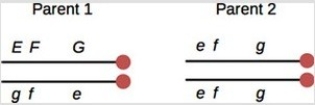Multiple Choice
In plants, genes E, F, and G are on one chromosome arm.Alternate dominant and recessive alleles of all three genes determine visible traits: E = normal leaf number, e = extra leaves, F = normal stems, f = furry stems, G = normal flower size, g = gigantic flowers.A plant that is heterozygous for an inversion involving all three genes is crossed to a plant with extra leaves, furry stems, and gigantic flowers.The arrangement of alleles is shown in the diagram.If you look at thousands of offspring of this cross, what phenotypes do you expect to see?  (Select all that apply. )
(Select all that apply. )
A) Most, but not all, offspring will be normal for all three traits or have extra leaves, furry stems, and gigantic flowers.
B) Due to double crossovers between E and F and F and G, a very small number of offspring will have only furry stems, or only extra leaves and gigantic flowers.
C) Half of the offspring will be normal for all three traits and half will have extra leaves, furry stems, and gigantic flowers.
D) Due to crossovers between E and F in parent 1, a small number of offspring will have only extra leaves, or only furry stems and gigantic flower size.
E) Due to crossovers between F and G, a small number of offspring will have only extra leaves and furry stems, or only gigantic flower size.
Correct Answer:

Verified
Correct Answer:
Verified
Q2: Wild oysters are diploid and have 20
Q3: Which sex chromosome aneuploidy is not usually
Q4: Which event could result in an inversion?<br>A)A
Q5: Which are possible results of an intragenic
Q6: What might result from movement of transposable
Q8: The type of mutation that results in
Q9: Inversions are most likely to affect an
Q10: An individual with one normal homolog and
Q11: Which is a mechanism by which transposable
Q12: Turner syndrome (XO)is a sex chromosome aneuploidy.Of